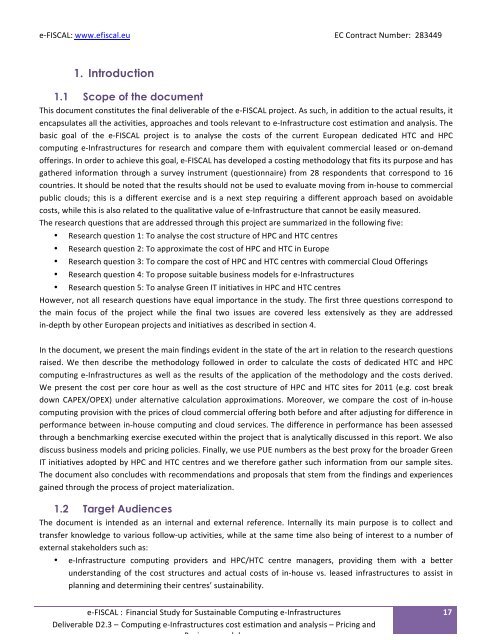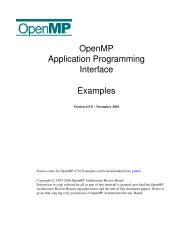D2 3 Computing e-Infrastructure cost calculations and business _models_vam1-final
D2 3 Computing e-Infrastructure cost calculations and business _models_vam1-final
D2 3 Computing e-Infrastructure cost calculations and business _models_vam1-final
Create successful ePaper yourself
Turn your PDF publications into a flip-book with our unique Google optimized e-Paper software.
e-‐FISCAL: www.efiscal.eu <br />
EC Contract Number: 283449 <br />
1. Introduction<br />
1.1 Scope of the document<br />
This document constitutes the <strong>final</strong> deliverable of the e-‐FISCAL project. As such, in addition to the actual results, it <br />
encapsulates all the activities, approaches <strong>and</strong> tools relevant to e-‐<strong>Infrastructure</strong> <strong>cost</strong> estimation <strong>and</strong> analysis. The <br />
basic goal of the e-‐FISCAL project is to analyse the <strong>cost</strong>s of the current European dedicated HTC <strong>and</strong> HPC <br />
computing e-‐<strong>Infrastructure</strong>s for research <strong>and</strong> compare them with equivalent commercial leased or on-‐dem<strong>and</strong> <br />
offerings. In order to achieve this goal, e-‐FISCAL has developed a <strong>cost</strong>ing methodology that fits its purpose <strong>and</strong> has <br />
gathered information through a survey instrument (questionnaire) from 28 respondents that correspond to 16 <br />
countries. It should be noted that the results should not be used to evaluate moving from in-‐house to commercial <br />
public clouds; this is a different exercise <strong>and</strong> is a next step requiring a different approach based on avoidable <br />
<strong>cost</strong>s, while this is also related to the qualitative value of e-‐<strong>Infrastructure</strong> that cannot be easily measured. <br />
The research questions that are addressed through this project are summarized in the following five: <br />
• Research question 1: To analyse the <strong>cost</strong> structure of HPC <strong>and</strong> HTC centres <br />
• Research question 2: To approximate the <strong>cost</strong> of HPC <strong>and</strong> HTC in Europe <br />
• Research question 3: To compare the <strong>cost</strong> of HPC <strong>and</strong> HTC centres with commercial Cloud Offerings <br />
• Research question 4: To propose suitable <strong>business</strong> <strong>models</strong> for e-‐<strong>Infrastructure</strong>s <br />
• Research question 5: To analyse Green IT initiatives in HPC <strong>and</strong> HTC centres <br />
However, not all research questions have equal importance in the study. The first three questions correspond to <br />
the main focus of the project while the <strong>final</strong> two issues are covered less extensively as they are addressed <br />
in-‐depth by other European projects <strong>and</strong> initiatives as described in section 4. <br />
In the document, we present the main findings evident in the state of the art in relation to the research questions <br />
raised. We then describe the methodology followed in order to calculate the <strong>cost</strong>s of dedicated HTC <strong>and</strong> HPC <br />
computing e-‐<strong>Infrastructure</strong>s as well as the results of the application of the methodology <strong>and</strong> the <strong>cost</strong>s derived. <br />
We present the <strong>cost</strong> per core hour as well as the <strong>cost</strong> structure of HPC <strong>and</strong> HTC sites for 2011 (e.g. <strong>cost</strong> break <br />
down CAPEX/OPEX) under alternative calculation approximations. Moreover, we compare the <strong>cost</strong> of in-‐house <br />
computing provision with the prices of cloud commercial offering both before <strong>and</strong> after adjusting for difference in <br />
performance between in-‐house computing <strong>and</strong> cloud services. The difference in performance has been assessed <br />
through a benchmarking exercise executed within the project that is analytically discussed in this report. We also <br />
discuss <strong>business</strong> <strong>models</strong> <strong>and</strong> pricing policies. Finally, we use PUE numbers as the best proxy for the broader Green <br />
IT initiatives adopted by HPC <strong>and</strong> HTC centres <strong>and</strong> we therefore gather such information from our sample sites. <br />
The document also concludes with recommendations <strong>and</strong> proposals that stem from the findings <strong>and</strong> experiences <br />
gained through the process of project materialization. <br />
1.2 Target Audiences<br />
The document is intended as an internal <strong>and</strong> external reference. Internally its main purpose is to collect <strong>and</strong> <br />
transfer knowledge to various follow-‐up activities, while at the same time also being of interest to a number of <br />
external stakeholders such as: <br />
• e-‐<strong>Infrastructure</strong> computing providers <strong>and</strong> HPC/HTC centre managers, providing them with a better <br />
underst<strong>and</strong>ing of the <strong>cost</strong> structures <strong>and</strong> actual <strong>cost</strong>s of in-‐house vs. leased infrastructures to assist in <br />
planning <strong>and</strong> determining their centres’ sustainability. <br />
e-‐FISCAL : Financial Study for Sustainable <strong>Computing</strong> e-‐<strong>Infrastructure</strong>s <br />
Deliverable <strong>D2</strong>.3 – <strong>Computing</strong> e-‐<strong>Infrastructure</strong>s <strong>cost</strong> estimation <strong>and</strong> analysis – Pricing <strong>and</strong> <br />
Business <strong>models</strong> <br />
17




